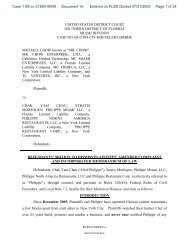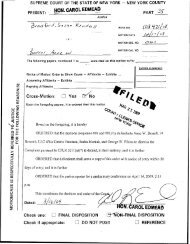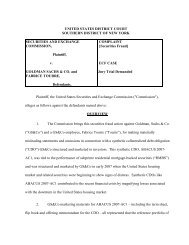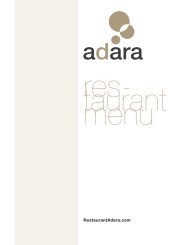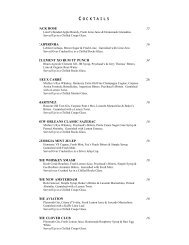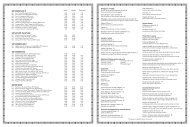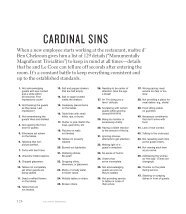Create successful ePaper yourself
Turn your PDF publications into a flip-book with our unique Google optimized e-Paper software.
56 THE MILE END COOKBOOK<br />
Lox<br />
Noah: We use this salt-cured salmon recipe for two of our signature<br />
breakfast dishes, the Beauty (page 98) and the Mish-Mash (page 109),<br />
but it’s great for all sorts of other preparations.<br />
Curing salmon is all about the fat. We use king salmon for making<br />
lox at the deli, and always the farmed variety, not wild. That’s because<br />
wild salmon tends to be too lean for curing. Too little fat will cause the<br />
salt mixture to “burn” the surface of the salmon and stop the cure from<br />
penetrating. Allowing the fillet to rest for a day after rinsing off the curing<br />
mixture enables the fish to continue “cooking"—that is, it lets the curing<br />
compounds distribute themselves evenly throughout the salmon. Using<br />
good kosher salt for this recipe is absolutely essential.<br />
cup whole black peppercorns<br />
cup sugar<br />
1 cup Diamond Crystal kosher salt<br />
1 bunch of dill<br />
1 2-pound boneless king salmon fillet, with skin<br />
Combine the peppercorns, sugar, and salt in a bowl and stir to combine. Place 2 or 3 sprigs of<br />
the dill in the bottom of a nonreactive baking dish, and sprinkle about ¼ cup of the salt mixture<br />
evenly over the bottom of the dish.<br />
Make 2 or 3 shallow cuts in the skin of the salmon fillet. Place the salmon, skin side down, on<br />
top of the salt and dill, and place a few more sprigs of dill on top of the salmon. Sprinkle<br />
the salmon all over with another ¼ cup of the salt mixture. Reserve the remaining salt mixture.<br />
Loosely cover the baking dish with plastic wrap and refrigerate it overnight.<br />
Carefully pour off any liquid that has accumulated in the baking dish. Add another ¼ cup of<br />
the salt mixture to the bottom of the dish, and sprinkle ¼ cup more over the salmon. Replace<br />
the dill sprigs with new ones if they’ve wilted. Cover the dish and refrigerate overnight.<br />
Repeat this process 2 more times over 2 more days.<br />
On the fifth day, remove the salmon, rinse it thoroughly, and pat it dry with paper towels. Place<br />
the salmon on a small drying rack set inside a clean baking dish or over a couple of layers of<br />
paper towels. Refrigerate, uncovered, overnight.<br />
To serve, slice very thinly and carefully at a shallow angle, working from the front of the fillet<br />
toward the tail.<br />
MAKES ABOUT 1½ POUNDS



